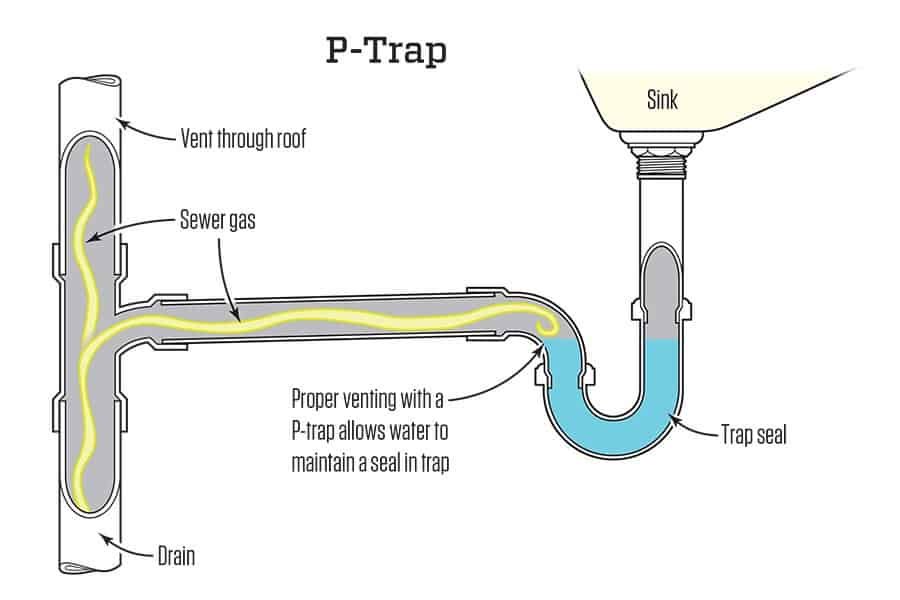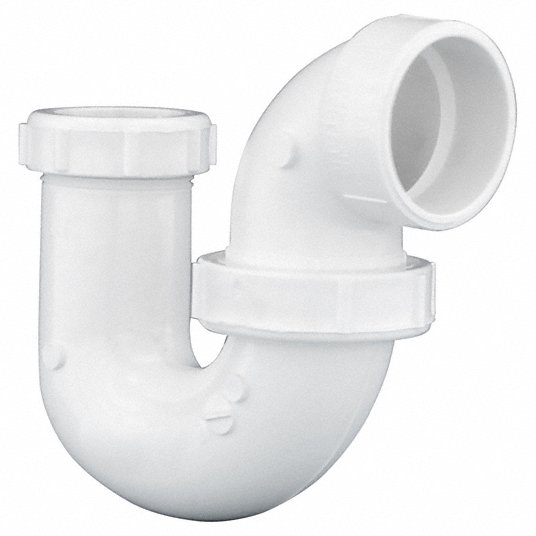The P trap is an integral part of your plumbing system and must be installed correctly.
In this article, we’ll answer the question of whether or not you can install the P trap backward.
We’ll also provide a complete guide to installing the P trap, so you can do it yourself, if necessary.
Let’s get started!
What is a P Trap?
P traps are plumbing fixtures that prevent foul odors from entering a home through the drains. They are usually installed in the bathroom and kitchen sinks. The “P” stands for “permanent,” as they are a permanent part of the plumbing fixture.
A p-trap comprises two pieces – a curved U-shaped pipe connecting to the drain and a stopper sitting at the bottom of the U-shape. When water flows down the drain, it creates a seal around the stopper, which prevents sewer gases from escaping into your home.
What Does P Trap Do?
A P-trap is a U-shaped pipe designed to prevent sewer gases and garbage disposal from entering a building while also allowing waste water to seep. The curve of the trap allows water to form a trap seal that blocks noxious gases from coming up through the drains.
Over time, this barrier can become less effective as grease and grime build up around the edges of the trap. That’s why cleaning your P-trap regularly, using a brush or a cloth dipped in hot, soapy water, is essential.
It would help if you were also confident to pour boiling water down the drain every once in a while to help dissolve any built-up gunk.

Can the P Trap Install Backward?
The P trap is designed to keep sewer gas and odors from entering your home through the drains. The trap is installed in the drain line and acts as a water seal between the drainage system and your home. The P trap must be installed correctly to function properly.
Many people believe that the P trap must be installed with the curved portion facing the sewer line to work correctly. However, this is not always the case. In some situations, installing the P trap backward may be necessary to allow proper drainage.
Suppose you are unsure about which way to install your P trap. In that case, it is best to consult a professional plumber or contractor who can evaluate your circumstance and provide the best guidance.
How to Determine if Your P Trap is Installed Correctly?
If you’re unsure whether your P trap is installed correctly, you can check a few things.
Check if the Trap arm is level with the drainpipe: The trap arm is the horizontal part of the P trap that connects to the sink drain pipe. It should be level with the drainpipe or slightly sloped downwards.
Water can siphon out of the P trap if it’s not level and allow sewer gases to enter your home.
To fix this, you’ll need to loosen the trap arm and readjust it until it’s level.

- Check if the P trap is properly sealed:
The P trap should be adequately sealed to the drain pipe. If it’s not, sewer gases can leak out and into your home.
To fix this, you’ll need to reseal the connection between the P trap and the drainpipe.
You can use a plumber’s putty or a silicone sealant.
Should you be unclear on how to do this, you should contact a professional plumber for help.
- Check if the P trap is vented correctly:
The P trap needs to be appropriately vented to work correctly.
If it’s not, sewer gases can build up in the P trap and eventually leak into your home.
To fix this, you’ll need to install a vent stack.
A vent stack is a pipe that connects the P trap to the outside of your home.
- Check if the P trap is the right size:
The P trap needs to be the right size to work correctly.
If it’s too small, water can siphon out of the P trap and allow sewer gases to enter your home.
If too big, sewer gases can build up in the P trap and eventually leak into your home.
Make sure your P trap is the right size, and measure your drainpipe’s diameter.
Then, buy a P trap with the same diameter as your drainpipe.
How to Install a P Trap the Correct Way? Step By Step

If you’re confused about installing P Trap, here is an easy guide.
Tools you’ll need:
- Pipe wrench
- Own p trap
- Teflon tape
- PVC primer (optional)
- PVC cement (optional)
Instructions:
Step #01: Place the P trap under the sink.
First, you need to identify where the P trap will be installed. The P trap is a U-shaped pipe that goes under your sink. It connects to two other pipes: the drain pipe and the tailpiece.
Step #02: Connect the P trap to the drainpipe
Next, you need to connect the P trap to the drainpipe. The drain pipe is the pipe that goes down from your sink. It’s usually made of metal or PVC. To connect the P trap to the drainpipe, use a pipe wrench.
First, put Teflon tape on the threads of the drainpipe. This will help create a watertight seal. Then, use the pipe wrench to screw the P trap onto the drainpipe.
Tighten the connection with the pipe wrench until it’s snug. But don’t over-tighten it, or you may damage the threads.
If you’re using PVC pipes, you can use PVC primer and cement to make a permanent connection.
Step #03: Connect the P trap to the tailpiece
Next, you need to connect the P trap to the tailpiece. The tailpiece is the pipe that goes down from your sink. It’s usually made of metal or PVC. To connect the P trap to the tailpiece, use a pipe wrench.
Step #04: Test the P trap
After you’ve connected the P trap to the drainpipe and tailpiece, it’s time to test it. Please turn on the water and let it run for a few minutes. Check for any leaks. If there are no leaks, congratulations! You’ve successfully installed your metal P trap.
If you have any questions or concerns, please get in touch with a plumber. They will be able to assist you in any installation issues you may have.
Benefits of Having a Correctly Installed P Trap:
There are several benefits to having a correctly installed P trap.
- It keeps sewage gases out of your house**:** The P trap is designed to create a water seal that traps drain sewer gases from entering your home. If the P trap is installed correctly, you don’t have to worry about leaking sewer gases into your home.
- P trap traps solids: The P trap is also designed to trap solids that go down your drain. This includes things like hair, food, and grease. The P trap prevents them from clogging your drain by trapping these solids.
- It prevents pests from entering your home: Sewer gases can attract pests, such as rats and cockroaches. If the P trap is installed correctly, you don’t have to worry about pests entering your home.
- It prevents water from siphoning out of the P trap: If the P trap is installed correctly, water can’t siphon out of it. This implies that flooding won’t harm your house.
- By doing this, sewage cannot back up into your house**:** If the P trap is installed correctly, then sewage can’t back up into your home. This means that you won’t have to deal with a nasty mess.
There are several advantages as you can see to having a correctly installed P trap. If you’re unsure of how to install a P trap, or if you have any questions, please contact a plumber. They will be able to assist you in any installation issues you may have.

Consequences of Having an Incorrectly Installed P Trap:
There are several consequences of having an incorrectly installed P trap.
- It can cause sewer gases to enter your home: If the P trap is installed incorrectly, then sewer gases can leak into your home. This can be a health hazard for you and your family.
- It can cause odors to enter your home: Sewer gases have a nasty odor that can enter your home if the P trap is installed incorrectly.
- It can cause water to back up into your home: If the P trap is installed incorrectly, then water can back up into your home. This can lead to flooding and other damage.
As a result, you can see, it is very important to make sure that the P trap or other plumbing traps are installed correctly. If you are not sure how to install it, then you should hire a professional plumber to do the job for you.
Conclusion
So, can the P trap install backward? Yes, it can, but a backwards trap is not recommended. If you install the p-trap backward you don’t get the velocity.
There are several consequences of having an incorrectly installed P trap. Therefore, it is preferable to employ a qualified plumber to complete the task for you.
We hope you found this blog post helpful. Do not hesitate to contact Hofen Sanitary if you have any inquiries. As a veteran manufacturer of sanitary ware products for over 17 years, we would be more than happy to help!

Thank you for reading!

